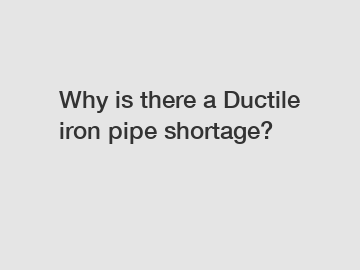Why is there a Ductile iron pipe shortage?
Why is there a Ductile iron pipe shortage?
Ductile iron pipes have become an essential part of our infrastructure, used extensively in water distribution systems, sewage networks, and other applications. However, in recent years, there has been a growing concern about a shortage of ductile iron pipes. This article aims to uncover the reasons behind this shortage, exploring various factors that have contributed to the problem.
1. Increasing demand and aging infrastructure:

One significant factor behind the ductile iron pipe shortage is the increasing demand for these pipes. As populations grow and urban areas expand, the need for water and sewage systems also increases. Additionally, many existing infrastructure networks are aging and require replacements or upgrades. This surge in demand has put pressure on the production capacity of ductile iron pipes, leading to shortages.
2. Limited production capacity:
The production process for ductile iron pipes involves multiple complex steps, including casting, heat treatment, and coating. These processes require specialized equipment and skilled labor, limiting the capacity for mass production. Moreover, some raw materials used in pipe production, such as pig iron and scrap steel, are also subjected to supply and price fluctuations. These limitations in production capacity, coupled with increased demand, have contributed to the shortage.
3. Disruptions in the global supply chain:
Ductile iron pipe production relies on a complicated global supply chain. Raw materials are sourced from various countries, and manufacturing plants may be located far away from the final project sites. Any disruptions along this intricate supply chain can have ripple effects on the availability of ductile iron pipes. Factors like natural disasters, political unrest, trade disputes, or the ongoing COVID-19 pandemic can all impact the production and transportation of these pipes, leading to shortages.
4. Competition from alternative materials:
Another noteworthy factor is the growing competition from alternative materials for infrastructure projects. As new technologies and materials emerge, some projects may choose to opt for alternatives like PVC, HDPE, or even fiber-reinforced polymer pipes. These alternatives may offer different advantages such as lower costs, easier installation, or resistance to corrosion. While these options may not be suitable for all applications, their increasing popularity can reduce the demand for ductile iron pipes.
5. Supply chain inefficiencies:
Inefficiencies within the supply chain can exacerbate the shortage of ductile iron pipes. Lack of coordination between manufacturers, distributors, and project developers can lead to delays and inventory shortages. Additionally, poor forecasting and inaccurate demand estimation can result in imbalances between supply and demand, causing gaps in availability.
In conclusion, the shortage of ductile iron pipes can be attributed to a combination of factors. The increasing demand due to urbanization and infrastructure development, limited production capacity, disruptions in the global supply chain, competition from alternative materials, and supply chain inefficiencies have all played a role in this predicament. As governments and industry stakeholders recognize the significance of addressing this shortage, efforts to improve production capacity, enhance supply chain resilience, and promote research and development of alternative materials will be crucial to meet the growing infrastructure demands of the future.
Contact us to discuss your requirements of 150mm ductile iron pipe, ceramic epoxy lined ductile iron pipe, en545 ductile iron pipe. Our experienced sales team can help you identify the options that best suit your needs.
208
0
0

Comments
All Comments (0)